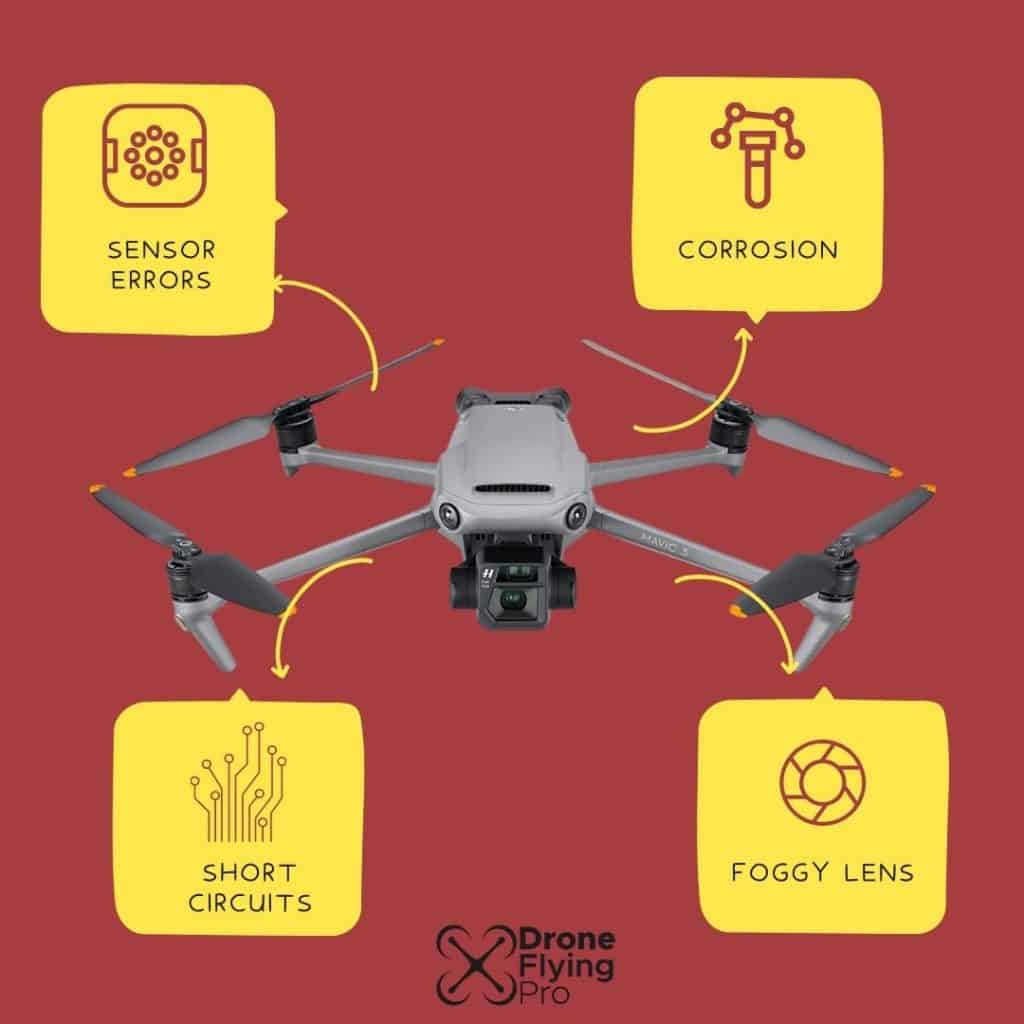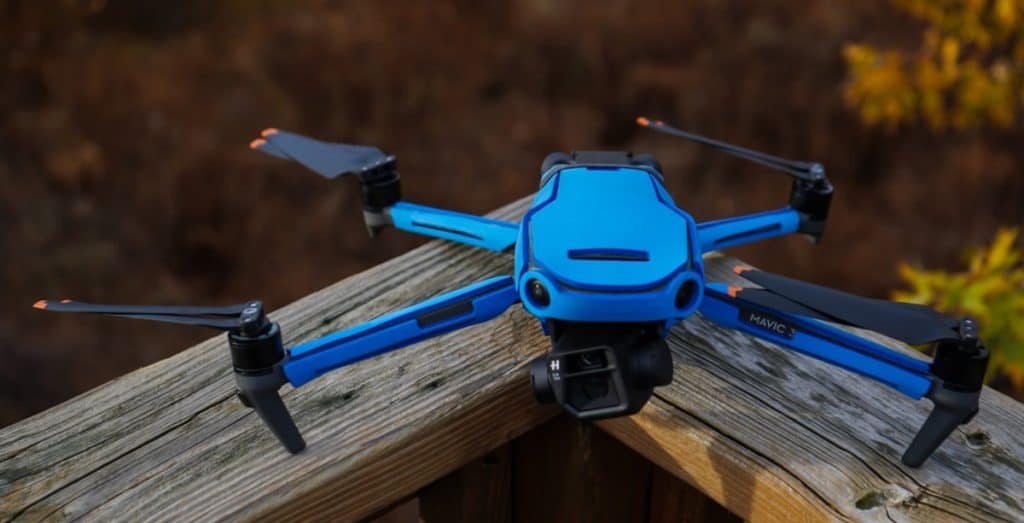The DJI Mavic 3 is an exciting new drone in the DJI ecosystem. It has an amazing camera with a 5.1 K resolution and omnidirectional obstacle sensing to make every flight safe and produce professional content. Many awesome flights are suspended for being put off by rain. So, are you able to fly the DJI Mavic 3 in the rain, and is it waterproof?
The DJI Mavic 3 is not waterproof. DJI recommends avoiding bodies of water and flying the drone in the rain so that water does not damage the drone and its internal components.
If you want to fly your Mavic 3 drone over large bodies of water, DJI recommends that you fly no closer than 3 m to the water’s surface. The water’s high refractive index and transparency can confuse the downward-facing sensors and cause the drone to land or get too close to the water.
Luckily, there are a couple of options for making your DJI Mavic 3 water-resistant so that you can fly in quite heavy rain.
Can Mavic 3 fly in the rain?
It is best not to fly your DJI Mavic 3 in the rain.
Sometimes, you may get caught short and accidentally fly your drone in the rain as it starts. I have flown my Mavic Air in a relatively heavy drizzle without damaging the drone, battery, or controller.
In the YouTube video, below, you can see that the pilot flies the Mavic 3 in light rain without any follow-up issues.
A word of warning: If you fly in the rain, the moisture stickers inside the drone will change colour to indicate that water has been present internally. DJI could use this to deny a warranty claim if you damage your drone later.
Light sprinklings of water are unlikely to damage the DJI Mavic 3 because drone pilots have noticed that previous models of DJI drones have conformal coatings on their boards. If you purchase a LED UV A-B light and shine it on the boards, you will see the coating on the board glow.
The coating doesn’t provide waterproof qualities but helps the circuit board stay water-resistant.
The conformal coating helps keep the electronics safe in humid areas and when condensation has formed on your drone.
Warnings from DJI
Here are all the warnings from the DJI Mavic 3 user manual that DJI wants you to know about water and rain.
- Water can affect the return-to-home capabilities of the DJI Mavic 3. You must fly manually over water and puddles due to rain.
- The vision system may not function properly when the aircraft is flying over water or snow-covered areas.
- Ensure that the infrared and vision systems are not covered in water, as it can affect the drone’s ability to detect its surroundings.
- FocusTrack cannot be used with objects in or over water.
- Do not fly the drone when it is raining, foggy, or there is no clear sight.
What happens if the DJI Mavic 3 gets wet?
Various issues may occur if your DJI Mavic 3 gets wet and there is significant water ingress into the drone and battery. From sensor errors to a continually foggy camera lens, these are best avoided by avoiding all contact with water and rain.

Sensor errors
Firstly, flying in the rain may put your drone at serious risk of crashing.
The omnidirectional avoidance system of the DJI Mavic 3 requires constant and predictable feedback from binocular and infrared sensors.
Water can sit on the surface of the glass covering the sensing system. The water will reflect and refract the light and infrared radiation, skewing the drone’s ability to detect the environment accurately.
The drone makes many calculations per second to keep the flight stable and safe. The system can only do this if it can rely on the information the drone is sensing about its environment. Once this information is incorrect, the drone could easily miscalculate its proximity to obstacles and the ground.
Corrosion
Any moisture that gets into the drone body could potentially cause corrosion on any circuit boards that are not protected with a conformal coating.
Rain water contains many minerals that have been dissolved into the water. The exact makeup of the minerals in the water depends on the location and the surrounding area’s geography. The water can easily deposit minerals into the deepest parts of your drone’s circuitry.
Also, corrosion can occur on any exposed metallic components. The act of oxidation on the exposed metallic components can cause the metal to become resistive to electrical flow.
Corrosion is particularly damaging to battery contacts as it will cause a huge amount of resistance, stopping the battery from providing the drone with resistance-free electricity.
Short circuits
The minerals in rainwater can cause short circuits to occur. Short circuits occur in the drone when two neighbouring electrical pathways connect. The water can easily bridge this gap and cause irreversible shorting between electronic components.
Foggy lens
The damage water can cause to a drone is not just limited to the electronic components.
Water can easily get between the camera and the lens, causing the images to look foggy. Getting water out of the drone’s lens can be incredibly frustrating and take many days and weeks of drying out in silicon beads.
Considering that the DJI Mavic 3 has a very complicated camera structure, I imagine it would be much harder to get the moisture out from the lens and camera body.
Most people buy the DJI Mavic 3 for its incredible two-camera photography system. It would be very frustrating if the drone could no longer perform its primary function of taking amazing photos without obvious fogging.
How to waterproof your DJI Mavic 3
There are several ways that you can waterproof your DJI Mavic 3. The first way is to buy third-party addition to stop the water from getting into your drone.
Wetsuit
A wetsuit for your drone can be purchased for really wet flying conditions.

The illumination wetsuit provided by Phantom Rain (this company) is a full-colour wetsuit that has been engineered to allow the DJI Mavic 3 to fly in the continuous pouring rain for hours.
The wetsuits have a five-level water-resistant system to allow the drone to fly in extreme rain without water getting into the battery or power button – areas typically prone to water ingress.
The wetsuit also provides a 4 mm impact layer to protect your drone from low-impact collisions. The installation will take about 15 minutes to apply the 23 parts to the drone.
The system has three battery covers, so you will always have a waterproof battery ready to fly.
In the above video, you will see how well the wetsuit performs in the rain.
Rescue jacket
For those looking for a solution to land on the water safely, the M3 jacket is perfect for the DJI Mavic 3.
It has been specifically designed to fit the Mavic 3 and the wetsuit. The low centre of gravity allows the drone to land on the water and float safely in rough waters. It can fly for up to 30 minutes in 20 mph winds.
The jacket weighs only 4.5 ounces, so the drone is not carrying too much extra weight.
Are the DJI Mavic 3 Controllers waterproof?
Of course, we cannot forget that the water will also potentially get into the controller of the DJI Mavic 3.
RC-N1
The RC-N1 remote controller requires you to place a smart device in the controller to view the first-person video stream.
The controller is very robust and will resist water but is not waterproof. However, your own smart device is the weakest point of this remote control for the rain.
You shouldn’t use the RC-N1 controller in rain as it can easily get water into the internal components and cause communication and control issues with the drone.
DJI RC Pro controller
If you opt for the new DJI RC Pro remote control as an accessory you need to be particularly careful in the rain.
The remote control includes a bright 5.5 inch display with a resolution of 1920×1080 pixels that can control the DJI Mavic 3 and stream its first-person live video feed.
The screen is not waterproof and you should avoid operating the remote control in direct rain.
The remote control is relatively expensive compared to the RC-N1 remote controller and you should always protect it from rain, snow, and high humidity areas.
There are likely to be moisture indicators in the body of the remote control, meaning that DJI may not replace it if they think that the remote control has come into contact with water. A word of warning for those looking to replace it under warranty.
Summary
This article has been through everything you need to know about whether the DJI Mavic 3 is waterproof and how you can fly in the rain and above water more safely.
All of the recommendations from DJI state that you should not fly the drone in rain, snow, or winds exceeding 13.8 m/s.
![Is the DJI Mavic 3 waterproof? [How to fly in the rain]](jpg/is-the-dji-mavic-3-waterproof-768x480.jpg)



